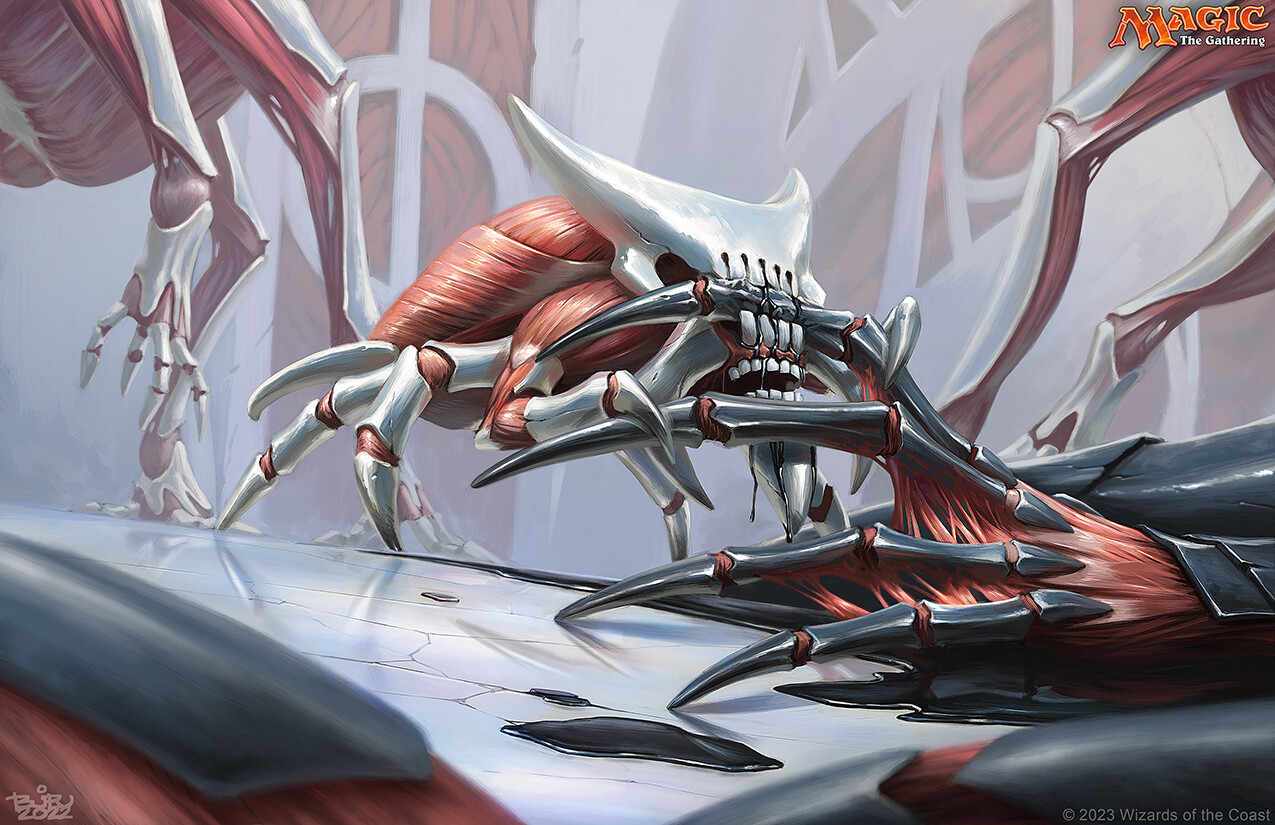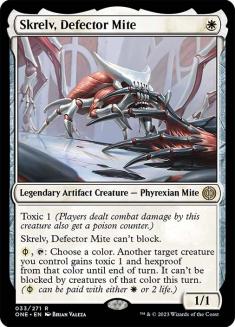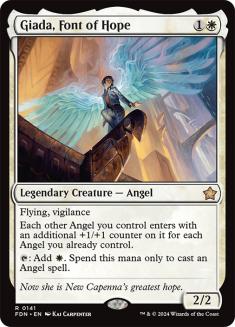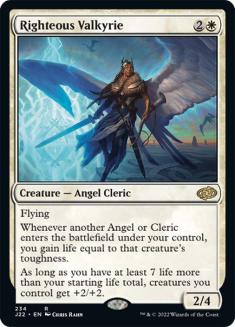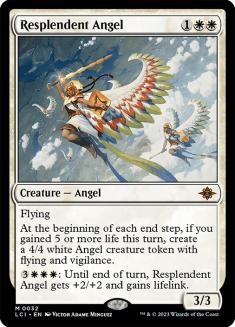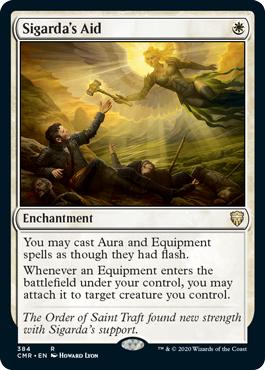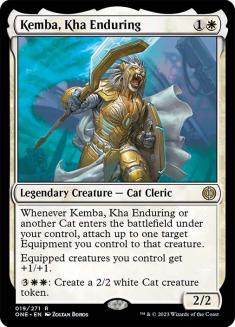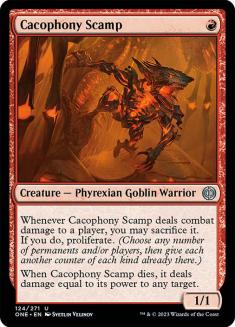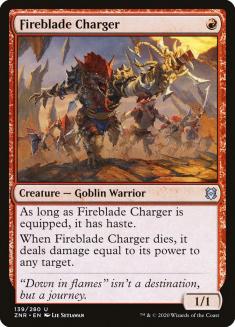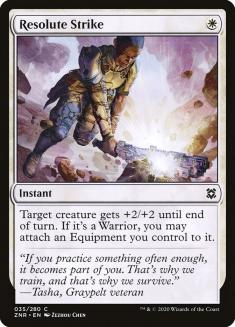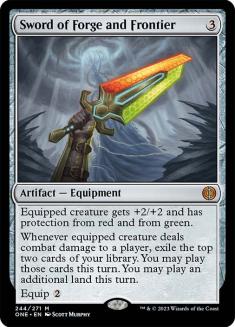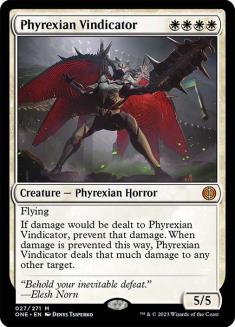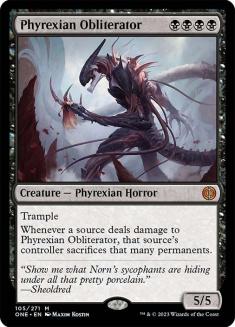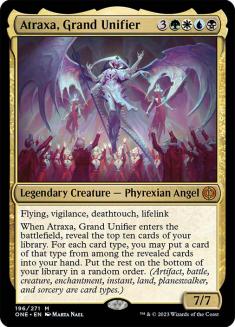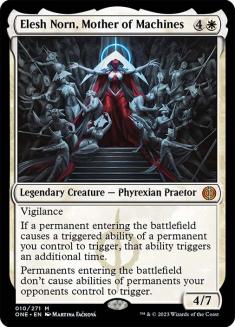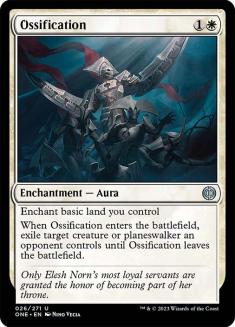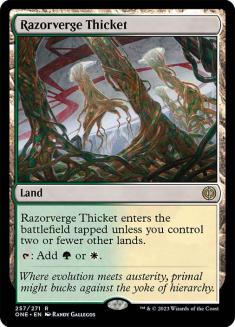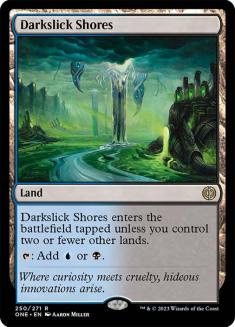Pioneer has been squarely in the spotlight for the past few months as the format for the first round of Regional Championships but it hasn’t stayed still. With a Pioneer Pro Tour on the horizon, the Phyrexians will want to take over this format too.
Skrelv, Defector Mite
In Modern, Skrelv, Defector Mite faces stiff competition from Giver of Runes, which in turn always lived in the shadow of Mother of Runes. Here in Pioneer, none of that matters – Skrelv is the only game in town. White creature decks suddenly have access to an effect that has proven to be reliably powerful even in larger formats.
Which of those decks are interested? Mono-White Humans has an abundance of one-drops already and cares about them having the Human creature type as well as their literal power. Protecting Thalia, her Lieutenant, or Adeline is appealing, but none of these is as threatening unless you have more aggressive one-drops applying pressure.
Selesnya Angels seems to be a more likely home at first. The deck’s main drawback is its clunky curve – it has no maindeck one-drops and effectively enters the game on Turn 2, so Skrelv has no competition there at all and lets you finally have a first-turn play. As a synergistic creature deck, you rely on your more expensive creatures surviving and working with each other, so it’s easy for a promising draw to crumble to a stream of removal spells from the likes of Rakdos Midrange. Skrelv offers a form of protection against that – if only by drawing that fire itself.
The problem is that you actually need to have combinations of creatures worth protecting in the first place, and without those, Skrelv is a weak card that doesn’t address that problem. The first Skrelv is a virtual mulligan sometimes – to say nothing of the second copy. Paying life for Phyrexian mana is a real cost in a deck that needs to hit the specific threshold of 27 life for Righteous Valkyrie.
Skrelv might revive a deck that is in the market for cheap artifacts.
Creatures (23)
- 4 Ornithopter
- 4 Gingerbrute
- 4 Ingenious Smith
- 3 Patchwork Automaton
- 4 Steel Seraph
- 4 Skrelv, Defector Mite
Lands (20)
Spells (17)

Decks like Azorius Ensoul were all the rage a year ago, when Kamigawa: Neon Dynasty gave us Michiko’s Reign of Truth and other artifact payoffs. These were centred in white, opening up a debate about whether the deck wanted blue for its namesake at all. After another brass bounty in The Brothers’ War and again in this set, an effectively mono-white artifact aggro deck is possible and appealing.
Cats and Hammers
One of the best decks in Modern might make the leap to Pioneer now:
Sigarda’s Aid has been legal in Pioneer since the start – not that you’d know it, since the supporting cast for the Hammer deck wasn’t there until now. Puresteel Paladin is a crucial form of redundancy and often your preferred enabler, but that one is still stuck on New Phyrexia from a decade ago – now Kemba, Kha Enduring hopes to fill that gap. Finding your Colossus Hammer is relatively easy – you don’t have Stoneforge Mystic and Urza’s Saga in Pioneer, but the weaker options are just about enough in a more forgiving format.
Sigarda’s Aid has been legal in Pioneer since the start – not that you’d know it, because the supporting cast for the Hammer deck wasn’t there until now. Puresteel Paladin is a crucial form of redundancy and often your preferred enabler but that one is still stuck on New Phyrexia a decade ago – now Kemba, Kha Enduring hopes to fill that gap. Finding your Colossus Hammer is relatively easy – you don’t have Stoneforge Mystic and Urza’s Saga in Pioneer, but the weaker options are just about enough in a more forgiving format.
Filling out the Hammer half is almost the easy part. Deciding what to attach it to is tricky. This list that Modern Hammer legend CrusherBotBG used to early success leans into Kemba’s tribal theme with a full clowder of cats and Kaheera, the Orphanguard as a companion. A more hyper-aggressive deck has a small Warrior theme with Resolute Strike as another equipper to suit up Cacophony Scamp or Fireblade Charger and chase the dream of a Turn 2 kill.
I Like Swords
The only ‘Sword of X and Y’ legal in Pioneer, the new Sword of Forge and Frontier is a welcome addition here as a solid Equipment for ‘fair’ games whose protection colours are popular in Pioneer.
This Sword is excellent against Llanowar Elves and Elvish Mystic, but even better alongside them. Birds of Paradise into Sword of Fire and Ice was a formidable start way back in original Mirrodin, but that play pattern has aged poorly in larger formats – Pioneer is the last place where a Turn 1 mana creature is still an ideal start. The most popular eight-Elf deck is Gruul Vehicles – perhaps the intended home and victim for this card. Unfortunately, that deck has so many good three-drops to choose between that all-stars like Fable of the Mirror-Breaker are stuck on the sidelines, and I expect Sword to join them there.
Mono-Green Devotion is the other deck that might love and hate this card, but it doesn’t disrupt the deck’s primary plan and opposing Swords are shut down by Karn, the Great Creator. It’s an option for your own Karn toolbox, but not an essential one.
Obliteration and Vindication
Phyrexian Obliterator is such a beloved design that bringing it back and printing a new homage to it are both easy calls. Obliterator looks much more dangerous than it is – creature decks like Gruul Vehicles that can’t remove it or go around it will struggle, but everything else can swat it away or ignore it entirely. Mono-Black Midrange is picking up some steam as an alternative to Rakdos, but even there Sheoldred, the Apocalypse should remain the finisher of choice. Obliterator might belong as a sideboard card against decks reliant on damage-based red removal, like the currently dormant Izzet Phoenix.
Phyrexian Vindicator lacks an obvious home – the closest things to mono-white decks in Pioneer have tribal themes that this misses and use the freedom of being a monocoloured deck to run colourless lands like Mutavault or Nykthos, Shrine to Nyx.
I had a sudden vision of pairing it with Heliod, Sun-Crowned and Boros Reckoner and cards that grant indestructible like Selfless Spirit or Archangel Avacyn to unlock those infinite combos (an indestructible Boros Reckoner that takes damage can keep hitting itself, which gains you life each time if it has lifelink) in a Mono-White Devotion deck. I was quickly informed that Vindicator both prevents the damage dealt to it and has to target something else anyway – just let me have my fun!
The Grand Unifier
Atraxa, Grand Unifier might be the most flexible ‘big thing’ to cheat out of all time. It works with everything – Flash! Natural Order! Sneak Attack! Reanimate! – in formats where that kind of mischief is part of the fun. In Pioneer, your best hope is to turn Leyline Binding into Atraxa with Enigmatic Incarnation – I certainly plan on doing that, but it’s just not the same.
Creatures (11)
Lands (19)
Spells (30)

Luckily, an already extant gimmick deck lets you indulge that urge. Combo enthusiasts could Neoform a six-drop delve creature like Tasigur, the Golden Fang or Hooting Mandrills into a six-power Velomachus Lorehold, which was just large enough to unearth extra turn effects like Karn’s Temporal Sundering or Part the Waterveil to keep this chain going. Otherworldly Gaze and Contingency Plan / Taigam’s Scheming let you fill the graveyard for delve, find your Neoform, and then stack the deck for Velomachus.
There are many reasons that this never took off, but a big one is that, well, you have to put these nigh-uncastable extra-turn cards in a deck that already had to assemble multiple specific pieces. Atraxa doesn’t have the same ceiling, but cheating it onto the battlefield with some protection (that Atraxa can even find itself!) should be enough to win most games. If the first Atraxa isn’t enough, its trigger gives you a lot of looks at another Neoform effect and delve creature to go again (with Tyrranax Rex as another seven-drop from the set that offers a fast, resilient clock).
Mother of Machines
Phyrexia’s most maternal Praetor is terrorizing Commander tables everywhere, but what about Pioneer? It’s an exciting one-of for the Enigmatic Incarnation toolbox, but we can lean on it much harder.
Creatures (27)
- 4 Knight of the White Orchid
- 4 Thraben Inspector
- 3 Thalia's Lancers
- 4 Charming Prince
- 1 Yorion, Sky Nomad
- 4 Skyclave Apparition
- 3 Reidane, God of the Worthy
- 1 Ambitious Farmhand
- 3 Elesh Norn, Mother of Machines
Planeswalkers (5)
Lands (10)
Spells (38)

As this deck demonstrates, it’s very easy to build a deck that goes berserk when you control Elesh Norn. What makes it intriguing is that it’s an effective hate card against a vast swathe of the format too – Selesnya Angels and Mono-White Humans look embarrassing against Elesh Norn, and also lose access to effects like Brutal Cathar that might easily remove another creature.
It’s not game over against Mono-Green Devotion, but disabling Cavalier of Thorns, Oath of Nissa, and Kiora triggers weakens their Storm the Festival and buys you a lot of time. It’s not only great in Enigmatic Incarnation, it’s great against it too! As more and more cards attach spells to permanents via enters-the-battlefield effects, decks accumulate cards that are turned off by Elesh Norn without consciously trying to.
Journey to Nowhere always felt like a card that ‘belonged’ in Pioneer, but we had to make do with a dozen riffs on Silkwrap instead. Ossification offers a mostly monocoloured deck (or a version of Azorius Control willing to sacrifice some of its dual lands) a strong removal option at that spot on the curve.
Fastlands at Last
The long-awaited reprinting of the Scars of Mirrodin fastlands finally gives the allied and enemy colours mana equality where it counts. Without knowing the contents of the set, it was a safe bet that these would be some of its most important cards.
Their impact will be felt unevenly. Copperline Gorge is a nice addition to the shaky Gruul Midrange manabase and Blackcleave Cliffs makes the mana less painful for Rakdos Sacrifice (though it’s a marginal improvement for its bigger brother in Rakdos Midrange).
The white lands are a boon for the various white creature decks that need to balance heavy coloured mana requirements – both Selesnya Auras and Azorius Auras are big winners from this set. Azorius and Bant Spirits are powerful decks held back by their mana, which is now much smoother. Some kind of Selesnya Company deck hoping to pair Elvish Mystic with Skyclave Apparition finally looks doable.
Darkslick Shores is the odd duck here. The one clear flaw in Dimir Inverter – the only deck in these colours to touch the top tier of Pioneer – was having to rely on awful fixing like Choked Estuary to keep its manabase together. The draw to Dimir is that you get to pair blue’s card filtering, like Opt and Consider, with black’s headliners in Fatal Push and Thoughtseize, but the previous fixing didn’t let you bridge that gap on Turn 1 and make use of that mana efficiency. Darkslick Shores puts that firmly in reach – but where, now that Inverter has been gone for years?
This spiritual successor to Inverter was one of the most fascinating developments in the past few months, but we can also explore a colourful twist on something more conventional:
Creatures (10)
Lands (18)
Spells (32)

Without its more expressive cousin, Galvanic Iteration is the only unique red card in Izzet Phoenix. Black offers a different suite of removal as well as a perfectly on-plan and proactive form of interaction in Thoughtseize. Shifting colours like this always looked appealing, but the mana simply didn’t support it – until now.
There’s more to mull over – is Tyvar the missing piece for Prime Speaker Vannifar or some other combo deck? – but the reprints alone promise to shake the format up for its return to the top rung of competitive play at the Pro Tour.

